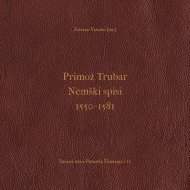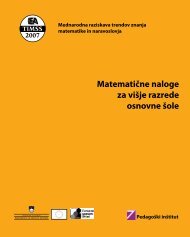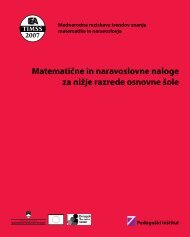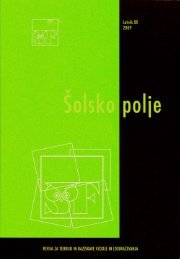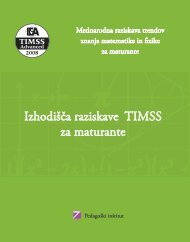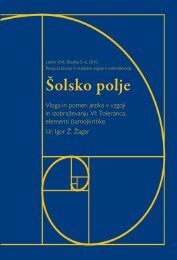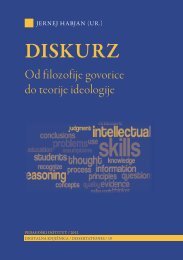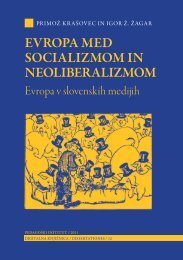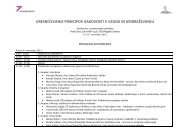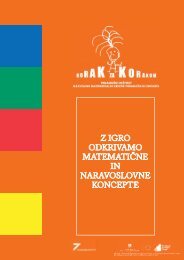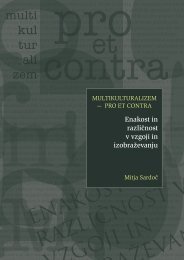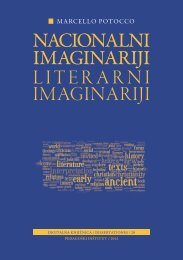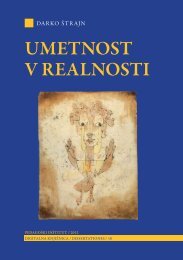56 ŠOLSKO POLJE LETNIK <strong>XX</strong> ŠTEVILKA 5/6the topos of national uniqueness) reinforces Poland’s attractivenessvis-a-vis the European Union: it argues (!) that Poland has a uniquerole as a ‘bridge’ between Europe’s East and West. Then, the topos ofpast and future also constructs (!) Polish national identifications, yetwithin the dichotomy between collective ‘scope of experience’ and‘horizon of expectations’ (Koselleck, 1989). While this topos is usedto emphasize that the Polish past might have been troubled and negative(...), it insists (!) that the Polish ‘European’ future will be almostentirely positive and peaceful.Unlike the previously elaborated (sic!) topoi, the topos of modernizationclearly stands out and reaches beyond (!) the constructionsof national identification. It focuses (!) mostly on presenting theEuropean Union as carrying some unique modernising force whichwould help reform Polish state and society. The topos of modernisationis therefore frequently tied to the topos of the EU as a nationalnecessity and to the topos of the EU as a national test of which bothconstruct the ‘power’ of the Union over Poland in a similar way. Byimplying that the Union is characterised by some unique principlesand standards of social and political organisation (...), the topos of modernisation,contrary to the previous ones, constructs a very positiveimage of the Union to the detriment of Poland, which is portrayed ina negative way.«Surprisingly, we learn that topoi in this rather long excerpt are »elaborated«,while Krzyzanowski doesn’t even gloss (on) them, let alone define themor give a possible pattern of their functionning (as Reisigl and Wodakdo in the first part of Discourse and Discrimination). In his analysis, thewords and phrases that are labeled topoi not only do not serve to connectthe arguments and the conclusions, but act on their own: they can be argumentsand conclusions, sometimes even both (actually, it is rather difficultto identify what arguments and conclusions could be in this text). Evenmore, they are clearly and openly antropomorphized, since they »seek«,»head back«, »argue«, »construct«, »insist«, »reach beyond« and »focus« (ifwe stay with the quoted part of the article).In their seminal work Traité de l'argumentation - La nouvelle rhétorique(1958/1983: 112-113), Chaim Perelman and Lucie Olbrechts-Tytecabitterly commented on the degeneration of rhetoric in the course of history,but what we have just seen in the above quote is not just degeneration,but pure vulgarisation and abuse of one of the most important rhetorical
TOPOI IN CRITICAL DISCOURSE ANALYSIS57concepts, the concept of topoi. So, it is probably high time that we answerthe crucial question: what are topoi?It is quite surprising that none of the quoted works even mention theorigins of topoi (theory), their extensive treatment in many works andthe main authors of these works, namely Aristotle and Cicero. And I havealready mentioned that the definition, borrowed from Kienpointner, doesnot come from them either (i.e. Aristotle and Cicero)..All this is even more surprising because it is today almost a commonplace(a topos of its own, if I may say so) that for Aristotle a topos is a placeto look for arguments (which is true), a heading or department wherea number of rhetorical arguments can be easily found (which is trueas well), and that those arguments are ready for use – which is a ratherbig misunderstanding. According to Aristotle (and above all, accordingto many of his commentators), topoi are supposed to be of two kinds:general or common topoi, appropriate for use everywhere and anywhere,regardless of situation, and specific topoi, in their applicability limitedmostly to the three genres of oratory (judicial, deliberative and epideictic;but we will come to that later). Or, as Aristotle (Rh. 1358a31-32 1.2.22) putsit: »By specific topics I mean the propositions peculiar to each class ofthings, by universal those common to all alike«.The Aristotelian topos (literally: ‘place’, ‘location’) is an argumentativescheme, which enables a dialectician or rhetorician to construe an argumentfor a given conclusion. The majority of Aristotle’s interpreters seetopoi as the (basic) elements for enthymemes, the rhetorical syllogisms. 7The use of topoi or loci, as the Romans have called them, can be tracedback to early rhetoricians (mostly referred to as sophists) such as Protagorasor Gorgias. But, while in earlier rhetoric topos was indeed understoodas a complete pattern or formula, a ready made argument that can bementioned at a certain stage of a speech (to produce a certain effect, oreven more important to justify a certain conclusion) – an understandingthat also prevailed with the Renaissance -, most of the Aristotelian topoiare general instructions allowing a conclusion of a certain form (notcontent), to be derived from premises of a certain form (not content).That is why I emphasized that a rather widespread conviction that Aristoteliantopoi were places where ready to use arguments could be foundwas a big misunderstanding. In fact, it is even more the other way round.
- Page 3:
VSEBINA LETNIK XX ŠTEVILKA 5/6 Z
- Page 7 and 8: UVODNA NOTICAIgor Ž. ŽagarTole pi
- Page 9 and 10: ZA KAJ GRE V KAD - PREGLEDZGODOVINE
- Page 11 and 12: ZA KAJ GRE V KAD - PREGLED ZGODOVIN
- Page 13: ZA KAJ GRE V KAD - PREGLED ZGODOVIN
- Page 17 and 18: ZA KAJ GRE V KAD - PREGLED ZGODOVIN
- Page 19 and 20: ZA KAJ GRE V KAD - PREGLED ZGODOVIN
- Page 21 and 22: ZA KAJ GRE V KAD - PREGLED ZGODOVIN
- Page 23 and 24: ZA KAJ GRE V KAD - PREGLED ZGODOVIN
- Page 25 and 26: ZA KAJ GRE V KAD - PREGLED ZGODOVIN
- Page 27 and 28: DISKURZ: FOUCAULT, LACLAU TERZAPOPA
- Page 29 and 30: DISKURZ: FOUCAULT, LACLAU TER ZAPOP
- Page 31 and 32: DISKURZ: FOUCAULT, LACLAU TER ZAPOP
- Page 33 and 34: DISKURZ: FOUCAULT, LACLAU TER ZAPOP
- Page 35 and 36: DISKURZ: FOUCAULT, LACLAU TER ZAPOP
- Page 37 and 38: DISKURZ: FOUCAULT, LACLAU TER ZAPOP
- Page 39 and 40: DISKURZ: FOUCAULT, LACLAU TER ZAPOP
- Page 41 and 42: DISKURZ: FOUCAULT, LACLAU TER ZAPOP
- Page 43 and 44: DISKURZ: FOUCAULT, LACLAU TER ZAPOP
- Page 45 and 46: DISKURZ: FOUCAULT, LACLAU TER ZAPOP
- Page 47 and 48: DISKURZ: FOUCAULT, LACLAU TER ZAPOP
- Page 49 and 50: TOPOI IN CRITICAL DISCOURSE ANALYSI
- Page 51 and 52: TOPOI IN CRITICAL DISCOURSE ANALYSI
- Page 53 and 54: TOPOI IN CRITICAL DISCOURSE ANALYSI
- Page 55 and 56: TOPOI IN CRITICAL DISCOURSE ANALYSI
- Page 57: TOPOI IN CRITICAL DISCOURSE ANALYSI
- Page 61 and 62: TOPOI IN CRITICAL DISCOURSE ANALYSI
- Page 63 and 64: TOPOI IN CRITICAL DISCOURSE ANALYSI
- Page 65 and 66: TOPOI IN CRITICAL DISCOURSE ANALYSI
- Page 67 and 68: TOPOI IN CRITICAL DISCOURSE ANALYSI
- Page 69 and 70: TOPOI IN CRITICAL DISCOURSE ANALYSI
- Page 71 and 72: TOPOI IN CRITICAL DISCOURSE ANALYSI
- Page 73 and 74: TOPOI IN CRITICAL DISCOURSE ANALYSI
- Page 75 and 76: TOPOI IN CRITICAL DISCOURSE ANALYSI
- Page 77 and 78: University of Queensland, Centre fo
- Page 79 and 80: JOURNALISTIC (RE)PRODUCTION OF HIST
- Page 81 and 82: JOURNALISTIC (RE)PRODUCTION OF HIST
- Page 83 and 84: JOURNALISTIC (RE)PRODUCTION OF HIST
- Page 85 and 86: JOURNALISTIC (RE)PRODUCTION OF HIST
- Page 87 and 88: JOURNALISTIC (RE)PRODUCTION OF HIST
- Page 89 and 90: JOURNALISTIC (RE)PRODUCTION OF HIST
- Page 91 and 92: JOURNALISTIC (RE)PRODUCTION OF HIST
- Page 93 and 94: JOURNALISTIC (RE)PRODUCTION OF HIST
- Page 95 and 96: JOURNALISTIC (RE)PRODUCTION OF HIST
- Page 97 and 98: JOURNALISTIC (RE)PRODUCTION OF HIST
- Page 99 and 100: JOURNALISTIC (RE)PRODUCTION OF HIST
- Page 101 and 102: JOURNALISTIC (RE)PRODUCTION OF HIST
- Page 103 and 104: THE VOICE OF AN AGENDA-SETTINGAUTHO
- Page 105 and 106: THE VOICE OF AN AGENDA-SETTING AUTH
- Page 107 and 108: THE VOICE OF AN AGENDA-SETTING AUTH
- Page 109 and 110:
THE VOICE OF AN AGENDA-SETTING AUTH
- Page 111 and 112:
THE VOICE OF AN AGENDA-SETTING AUTH
- Page 113 and 114:
THE VOICE OF AN AGENDA-SETTING AUTH
- Page 115 and 116:
THE VOICE OF AN AGENDA-SETTING AUTH
- Page 117 and 118:
THE VOICE OF AN AGENDA-SETTING AUTH
- Page 119 and 120:
THE VOICE OF AN AGENDA-SETTING AUTH
- Page 121 and 122:
THE VOICE OF AN AGENDA-SETTING AUTH
- Page 123 and 124:
THE VOICE OF AN AGENDA-SETTING AUTH
- Page 125 and 126:
THE VOICE OF AN AGENDA-SETTING AUTH
- Page 127 and 128:
THE VOICE OF AN AGENDA-SETTING AUTH
- Page 129 and 130:
THE VOICE OF AN AGENDA-SETTING AUTH
- Page 131 and 132:
THE VOICE OF AN AGENDA-SETTING AUTH
- Page 133 and 134:
THE VOICE OF AN AGENDA-SETTING AUTH
- Page 135 and 136:
‘68 KOT HKRATNA KRIZA EVROPSKEGAZ
- Page 137 and 138:
‘68 KOT HKRATNA KRIZA EVROPSKEGA
- Page 139 and 140:
‘68 KOT HKRATNA KRIZA EVROPSKEGA
- Page 141 and 142:
‘68 KOT HKRATNA KRIZA EVROPSKEGA
- Page 143 and 144:
‘68 KOT HKRATNA KRIZA EVROPSKEGA
- Page 145 and 146:
‘68 KOT HKRATNA KRIZA EVROPSKEGA
- Page 147 and 148:
‘68 KOT HKRATNA KRIZA EVROPSKEGA
- Page 149 and 150:
‘68 KOT HKRATNA KRIZA EVROPSKEGA
- Page 151 and 152:
‘68 KOT HKRATNA KRIZA EVROPSKEGA
- Page 153 and 154:
‘68 KOT HKRATNA KRIZA EVROPSKEGA
- Page 155 and 156:
‘68 KOT HKRATNA KRIZA EVROPSKEGA
- Page 157 and 158:
‘68 KOT HKRATNA KRIZA EVROPSKEGA
- Page 159 and 160:
POVZETKI/ABSTRACTSZA KAJ GRE V KAD
- Page 161 and 162:
POVZETKI / ABSTRACTS159NOVINARSKA (
- Page 163 and 164:
POVZETKI / ABSTRACTS161‘68 AS PAR
- Page 165 and 166:
AVTORJI/AUTHORSRuth WodakRuth Wodak
- Page 168 and 169:
166 ŠOLSKO POLJE LETNIK XX ŠTEV
- Page 170 and 171:
168 ŠOLSKO POLJE LETNIK XX ŠTEV
- Page 172:
ZAHVALARevija Šolsko polje izhaja



